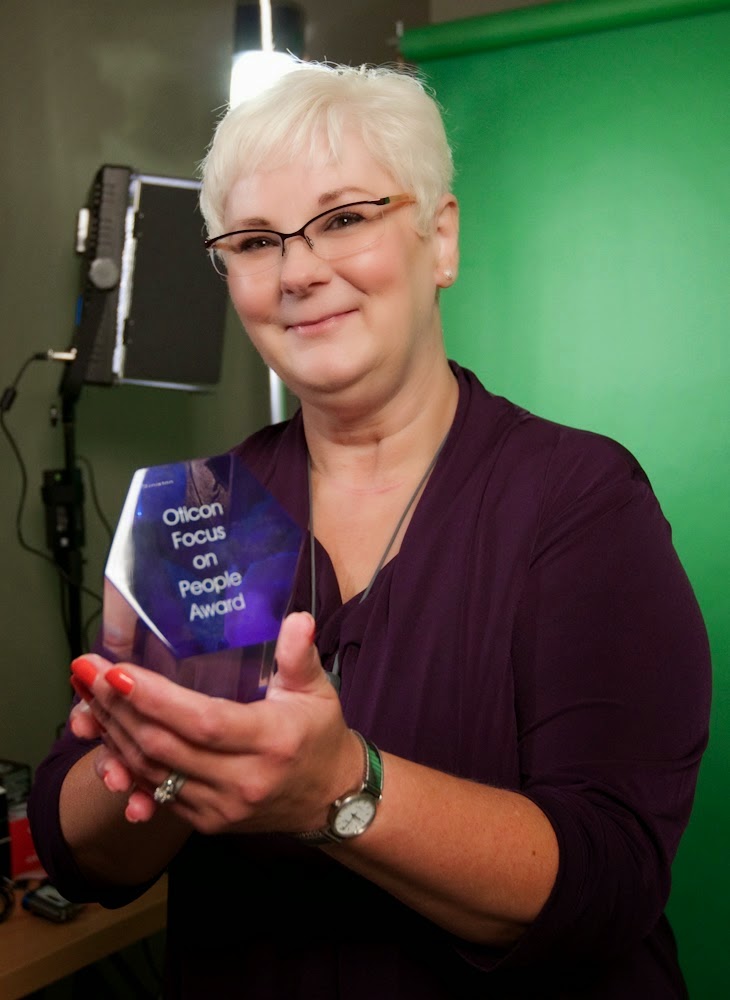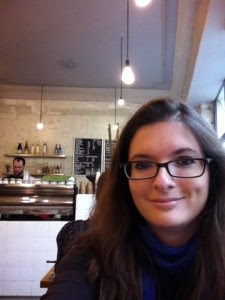For Joyce Edmiston, 55, who admits she can’t hear her oven timer beeping when she removes her hearing aids, even if she’s in the kitchen, says lack of awareness of these audio alerts and other sounds can be a real problem.
OtoSense, a sound recognition software company, has developed the first mobile app that identifies and distinguishes the source of incoming audio alerts, including alarms, sirens, timers, bells and other sounds, turning smartphones and tablets into assistive alerting devices for the deaf and hard of hearing.
 |
Joyce, who runs http://xpressivehandz.
blogspot.com is seen here
with an award. |
For people like Joyce and Travis Dougherty, 33, who is deaf, OtoSense offers an adaptable, affordable and useful means of being notified of important sounds in their environment.
Wherever you go, it seems, people, young and old, are using smartphones and tablets. The real value of these devices, however, comes from the mobile applications.
Smartphones have quite literally become the new form of an assistive device – the all-in-one system that is made all that more powerful with the mobile applications available to download. Today, there are apps that let you watch (even in closed captions), text, video chat, bank, shop, read, listen, take photos and movies, check the weather, traffic and even get updated arrival and departure times during busy holiday travel season.
Travis, who admittedly is an early adopter when it comes to new technology, says that the time has come for alerting devices to evolve and “putting this kind of technology into a smartphone and tablet just makes sense.”
Since the birth of his daughter, Travis now wears a Pebble smartwatch, which connects to OtoSense, and he will soon connect the app to his Philips Hue Lights when the next update comes out later this month.
Most people today have their smartphone and/or tablet within arm’s reach at all times, it’s the portable computer in their pocket and charging it and keeping it running is important. Certainly that’s the case for Noelle Bell, 32, who has a cochlear implant.
OtoSense works immediately upon download, coming with a built-in library of standard fire and smoke alarm sounds found in the U.S. and Europe. Additionally, OtoSense can be personalized by users, recording and storing the most significant sounds of their environment, notifying users via flash, vibration and third-party notification including SMS text and push notification.
 |
Noelle Bell, founder/CEO of
Buzz Worthy Social Media. |
For Noelle, who pairs OtoSense with her Pebble Smartwatch, says she’s taught the app the sounds of her alarm clock, the doorbell, oven timer and dog barking.
“It lets me know the audio cues to participate in my environment, and has helped me not feel as isolated in trying to figure out all of the different sounds of modern life,” says Noelle. “For me, the sound of the oven beeping is very similar to the sound of my doorbell, and I’ve recorded both sounds and stored them in my personal library on OtoSense. Now I can distinguish the difference between the two, and that is a real benefit.”
OtoSense is available now on the Google Play store. When the iPhone and iPad versions come out later this month, the cost of the app, on either Google Play or the App Store, will be $4.99 with some additional in-app purchases. OtoSense connects to any smartwatch, alerting user via text and vibration of a particular sound they have recorded and want to be aware of. And with the launch of the app on the App Store, users will be able to connect the app to Philips Hue Personal Wireless Lighting, customizing notifications.
According to the World Health Organization, there are 390 million people who suffer from a disabling hearing loss. In the United States, there are 48 million people who report a hearing loss according to the Hearing Loss Association of America.
Please follow OtoSense on Twitter at
www.twitter.com/otosense, like us on Facebook at
www.facebook.com/otosense, and Instagram at
www.instagram/otosense. If you have questions or want to sign up for our email list, please go to
www.otosense.com or email us
atexplorers@otosense.com.
This guest blog post was writting by Kathryn M. Quirk. Kathryn leads marketing activities for OtoSense, bringing more than 15 years of experience developing and managing multi-channel communications programs across an array of business sectors. Kathryn has insatiable thirst for news and information, reading, listening and watching everything with eye for how she can develop and share good stories, with a preference for sharing stories about how technology helps people to live more independent and autonomous lives. Always in the back in her mind, are the words of Maya Angelou, who wrote, “People will forget what you said. People will forget what you did. But people will never forget how you made them feel.”



Thank you so much for your blog. I have been using it as reference for my students during Android Course in Chennai. It has been so much useful, keep writing more 🙂
Thanks for sharing this information.
Thank you for sharing.